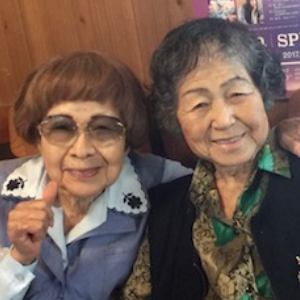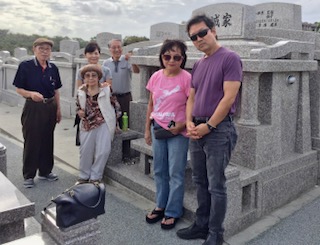Janice Suetomi and her best friend and neighbor, Fumiko, while growing up in Taira, Okinawa. They are the same age at 89 in 2019. Janice Suetomi is one of the few remaining Himeyuri Nurses today!
Himeyuri:
A Story of War, Death, Life and Peace
By Jodie Chiemi Ching
Janice Suetomi and her children pay respects to her ancestor at the dhaka in Okinawa.
Arriving to our interview, Janice Suetomi (born Fumiko Tamaki) smiled, oshare in white pants, and a purple and lavender floral blouse. But, her smiles turned to sorrow, as she recalled her time in the caves. “Tsurakatta,” she says with a soft voice. Pain, bitterness, and heartbreak showed on her face as she began to talk about the Battle of Okinawa that began in 1944.
The Beginning—A young girl’s dream
At 11 years old, Suetomi dreamed of becoming an elementary school teacher. With encouragement from her teachers, Suetomi studied vigorously and became the only student from Taira Village (within Tomigusuku, Okinawa) to pass the entrance exam for the Okinawa First Girls’ High School. There were 400 hundred female applicants from all over Okinawa and only 40 were accepted. The schools motto, “Aim for the Development of Highly Intellectual and Well-Cultivated Women” inspired Suetomi to pursue her dream. Even with such a great accomplishment, Suetomi’s parents did not praise her. “I was the eighth child of ten children from a poor family. After finishing elementary school all my brothers and sisters went to work as housekeepers for other families and contributed to our family’s income,” explained Suetomi. But, with the support of teachers, her parents let her go to school. Although going against the wishes of her parents, Suetomi’s future looked bright, until around March 1944.
Preparing for war
By this time World War II was well under way, resulting in a ground battle between the U.S. Forces and the Japanese Imperial Army on the islands of Okinawa, and forced local residents to become involved in the war. To delay the imminent battle from arriving on the mainland for as long as possible, the Japanese forces strategized to hold the progress of the American attack on the island of Okinawa. The Japanese soldiers hid in underground caves and fought an enemy who possessed far more fire power. The U.S. naval bombardment is known today as the “Storm of Steel” that lasted three months and took the lives of over 200,000 combatants and civilians.
On the eve of the Battle of Okinawa, Japan organized the army’s 32nd Unit, also known as the Okinawa Defense Unit. Gradually, more troops became stationed in Okinawa and school buildings were used as barracks. Male and female students at 21 secondary schools in Okinawa were mobilized for the war effort and soon found themselves on the battlefield. Local students assisted in building encampments or raising food supplies, while schools reduced class hours.
From November of 1944 military surgeons were offering nursing education to prepare for the mobilization of the students to work in army hospitals. Female students between the ages of 15 and 19 worked as nurses known as Himeyuri, or the Lily Corps. The Tekketsu Kinōtai, Blood and Iron Loyalist Student Corps, included male students from 14 to 19 years of age. In charge of transporting supplies, repairing bridges and electric cables, and delivering telegraphs, these young men exposed themselves to heavy bombardment daily.
Located next to each other, both the Okinawa Female Normal School and Okinawa First Girls’s High School stood in the Asato district of Naha City. From these schools, 222 students and 18 teachers proceeded to the Okinawa Army Field Hospital in Haebaru Town. All the girls, including Suetomi, thought they were going to a clean hospital building. Instead the Army Field Hospital’s unit were in about 30 cave tunnels dug into the mountains. A typical cave tunnel measured 230 feet deep and about six feet high, with bare dirt and rock walls. Only candles lit the dark dank caves.
Hell on earth
As the battle intensified, by April 1, 1945, the caves were crowded with wounded soldiers who lay on narrow bare wood plank beds. Each patient received a canteen of water, a small dish for food, and a pot in which to relieve themselves in. The young teenage nurses tended to hideous wounds, lost limbs, and mental trauma daily. The Imperial soldiers managed the groups within the caves and instructed the girls on what to do. “We had to take care of the wounded soldiers and feed them. Soldiers would deliver food--usually rice in buckets. We would make onigiri and feed the soldiers. We ate that too. There was no meat. Once in a while, we were lucky and had vegetables, but very little,” explained Suetomi.
Young Rumiko Tamaki (second row, third from the left) with her fellow Himeyuri nurses. The dots may have been placed on the photo digitally to identify the students. (Photo provided by Janice Suetomi)
She remembered how unsanitary it was, they were short on supplies, and food and water were becoming scare. Many of the wounded soldiers screamed and moaned, and were infested with maggots, especially in their mouths and ears. In order to salvage supplies, bandages were changed every two weeks. The nurses removed maggots from their wounds as part of their job. Anesthesia was not always available and nursing aids assisted in restraining patients during amputation and completed the job by burying the mangled limbs.
It was also their job to bury the dead. Going out during the day was not an option, they could hear the gunfire and explosions right outside the caves. “We had to bury bodies at night and we had to work quickly,” Suetomi says, her hands motioned as if they never forgot how to move the dirt to bury soldiers. She continued, “There was no time to relax, we just focused on our work.” Even at night, there was still risk of going into the line of fire. The girls even stopped menstruating due to the unrelenting stress and lack of nutrition.
Suetomi’s daughter Nancy recalls one story from her mother, “I know my mother had it tough during the war, hiding in caves and eating grass. She even got hit (by shrapnel) in the back and the hole is still there. It was a life and death situation on a daily basis for my mother.”
Evacuation from Haebaru to Itoman
In May 1945, U.S. forces advanced toward Shuri where Japan’s Army headquarters were located. On May 25th, 1945 an evacuation order was given to the occupants in the Haebaru Army Field Hospital. While some students helped patients who could walk, others carried supplies, documents, and medicine in their rucksacks. They headed south braving a barrage of shells. The combination of bombs and persistent rain turned the roads to muddy swamps. Corpses scattered the ground and severely wounded patients who lost their limbs crawled in the mud. Patients unable to walk were given poison and left in the caves of the Haebaru Army Field Hospital, maybe out of compassion, or maybe to prevent them from revealing confidential information if captured by the U.S. Army. Two gravely injured student could not be moved and were also poisoned and left behind in Haebaru.
They headed toward Ihara in Itoman City, which today, is the home of the Okinawa Peace Memorial Park. In this area, there were many gama, or natural caves, where civilians took shelter. The army forced the civilians hiding in these caves to get out and the Army Field Hospital took shelter in six separate gama. By now, they ran out of most medical equipment and medications and soon ceased to function as a hospital. The caves were not suitable for receiving injured soldiers, but, in the midst of shellfire, the students still continued to carry out their tasks securing food and water, and sending messages.
One day, there was a call outside the cave where Suetomi was hiding with other Japanese soldiers and student nurses. U.S. army soldiers said, “Come out, we have food.” No one went out of the cave. Then a tear gas bomb was thrown in and Suetomi the other nurses laid face down on the ground. The bomb blew up and bodies of the standing soldiers in the cave fell down onto them. Suetomi says, in her area of caves she guesses there were a few hundred people hiding, but only four survived that particular attack.
At midnight on June 18th, the students were issues a deactivation order at the Army Field Hospital. With the U.S. Forces closing in, there was heavy bombardment outside everywhere they looked. Nevertheless, the students were forced to leave the cave and fend for themselves. They had worked so hard to save the lives of the soldiers, believing their country would win, they were mortified to learn they had lost and thrown into the battlefield. This is when Himeyuri experienced a majority of their casualties.
Being sent to the concentration camp after surrendering to the U.S.
A week after the deactivation order, the group was hiding near Cape Kyan, the southern most tip of Okinawa, when U.S. troops surrounded them. The students found a grenade and decided that they would pull the pin and die together. They were told if captured, they would be raped and murdered. However, their teacher, Seizen Nakasone persuaded them to wait and surrender instead. He promised, that if he felt something was wrong, he would signal for them to jump off the cliff.
All the men were asked to take off their shirts, and Suetomi says, after that, they became separated from their teacher. The U.S.troops transported her to a concentration camp in Nago. Although Japan surrendered and the war was officially over, it was still a life of hell in Okinawa. About 100,000 people lived in three camps set up in the area now known as Nago. With unsanitary conditions and lack of food, people died everyday from malaria and starvation. Bodies had to be buried in mass graves.
Suetomi’s daughter remembers her mother’s stories about the concentration camps, “My mom saw a couple, and she knew their daughter. She couldn’t speak to them because she buried the daughter (in Haebaru) who lost her leg and died. She was scared to tell them what happened.”
“If I knew his name, I would fly to wherever he is and thank him for saving my life,” she said.”
While at the concentration camp, Suetomi suffered from malaria, but a kind soldier nursed her back to health. She never got his name. “If I knew his name, I would fly to wherever he is and thank him for saving my life,” she said.
Suetomi got word that her family was alive and was told their location. She left the concentration camp in search of her family and found them. It was an emotional reunion after months of not knowing if they were alive. The family decided to return to their house in Taira. When they arrived, other families occupied the home. They explained to the family that they were the owners of the house, to which they were told, “This is war! There is no such thing as ‘your house.’” They ended up living in a barn adjacent to an acquaintance’s house until eventually they were able to return to their home in Taira.
A new chapter: Normal life and work on the military base
When Suetomi was able to work, she got a job on the Tengan Army Base in the motor pool section. There, her work required her to get a driver’s license. There were 97 men and three women who were training to get their license. Two of the women dropped out and she became he first woman in Okinawa to receive a driver’s license. Being the only woman driver on the island of Okinawa, she turned a lot of heads. She drove U.S. military officers around to their meetings. “I used to drive the captains and sergeants around and waited outside the building by my car while they had their meeting. That’s when all the guys would come and flirt with me,” says Suetomi with a big smile. And that’s how she met her husband, James Isamu Suetomi, who was civil service auto-mechanic that worked in the motor pool in Okinawa and the luckiest of all the men who wanted a date with Janice.
`Ohana
James and Janice married had five children and 11 grandchildren. James passed away in 1984, but Janice continues to be very spirited and blessed with now 88 years of life surrounded by a loving family. They are all affected by her stories of what she endured, Hell on Earth.
Her eldest daughter, Betty Stubblefield, shared her perspective, “I grew up hearing war stories from my mom when we were little but they didn’t really have that much of an impact on me until I toured the Himeyuri Peace Museum in 2015. We went through each room read through every document, looked at each photo (of the girls), and watched all the videos. After exiting the museum, I cried my heart out. Even after we went back to our hotel room, whenever I thought about what my mom went through, I would burst into uncontrollable tears. That was the very first time I truly understood even a small portion of what she had lived through.”
“She was very strict and sometimes overprotective in raising us. She always worked hard at giving us the best in life. The war has impacted her in a positive way. She is always strong, lifting everyone else up and encouraging us to do our best.”
There is one word Suetomi’s children and grandchildren all use to describe her—tough. Her youngest daughter Amy recalls, “She was very strict and sometimes overprotective in raising us. She always worked hard at giving us the best in life. The war has impacted her in a positive way. She is always strong, lifting everyone else up and encouraging us to do our best.”
In addition, Suetomi was ahead of her time, flexing her independence as a woman, something that her grandson, Elton Gray, has great respect for. “She married a Japanese-American from Hawaii. That was a huge deal in her day. She embraced America and even named her children American names: Betty, Roy, Esther, Nancy, and Amy. And she changed her own name from Fumiko to Janice.” He goes on to say, “She is kind and tough. She appreciates everything around her, but also carried the wisdom and knowledge from her experiences. I love my grandma.”
A message of peace
Janice Suetomi (seated fourth from the left, holding bouquet) was the guest of honor at a family reunion in Okinawa in November 2017.
Suetomi’s single wish is for the younger generation to “please help one another so we can live in a world of peace.” She shares her experience, not to place blame on anyone, but in hopes that we all live in peace. Suetomi’s grand-daughter Chelsea Stubblefield talks about her grandma’s compassion, “I remember her telling me that wartime was hard. She didn’t want her children to struggle like she did, so she worked hard to raise them with love and happiness, giving them the best of everything. She laughed and reminisced about one of her friends telling her that her children were her delicate flower garden. She treasured them so.”




